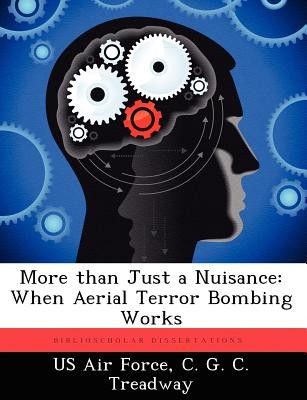
- We will send in 10–14 business days.
- Author: C G C Treadway
- Publisher: BiblioScholar
- ISBN-10: 1249328365
- ISBN-13: 9781249328360
- Format: 18.9 x 24.6 x 0.3 cm, softcover
- Language: English
- SAVE -10% with code: EXTRA
Reviews
Description
Strategic bombing against civilian targets was attempted on a grand scale during the Second World War against Britain, Germany, and Japan. Although the physical destruction was great, the coercive effect on the leadership of these states was questionable. However, in 1991, air attacks of negligible military or destructive value against cities in Israel imperiled the very existence of the allied coalition arrayed against Saddam Hussein. If large, continuous, destructive air attacks against civilian targets did not work in the past, why should small, brief, minimally destructive attacks coerce leaders now?
This thesis examines three campaigns during which aerial terror raids, peripheral to the main war efforts and incapable of destroying the enemy war-making capacity, elicited disproportionate reactions from the targeted leaderships. The raids on London during World War I, the V-1 and V-2 raids on London three decades later, and the Scud attacks on Israel during Desert Storm each show evidence of overreaction by Allied/coalition leaders.
A review of the nature of terrorism and of airpower reveals that aerial weapons are uniquely suitable as terror weapons. An analysis of the differences between nuisance attacks and conventional civilian bombing, along with an understanding of the pressures on the leaders involved, leads to an explanation for past overreactions: aerial terror raids shock targeted leaders into visceral responses. Historically short-lived, these responses are based on the pressures of representative government and the tendency to overestimate the capability of terror weapons while underestimating the resilience of the population.
EXTRA 10 % discount with code: EXTRA
The promotion ends in 17d.16:16:54
The discount code is valid when purchasing from 10 €. Discounts do not stack.
- Author: C G C Treadway
- Publisher: BiblioScholar
- ISBN-10: 1249328365
- ISBN-13: 9781249328360
- Format: 18.9 x 24.6 x 0.3 cm, softcover
- Language: English English
Strategic bombing against civilian targets was attempted on a grand scale during the Second World War against Britain, Germany, and Japan. Although the physical destruction was great, the coercive effect on the leadership of these states was questionable. However, in 1991, air attacks of negligible military or destructive value against cities in Israel imperiled the very existence of the allied coalition arrayed against Saddam Hussein. If large, continuous, destructive air attacks against civilian targets did not work in the past, why should small, brief, minimally destructive attacks coerce leaders now?
This thesis examines three campaigns during which aerial terror raids, peripheral to the main war efforts and incapable of destroying the enemy war-making capacity, elicited disproportionate reactions from the targeted leaderships. The raids on London during World War I, the V-1 and V-2 raids on London three decades later, and the Scud attacks on Israel during Desert Storm each show evidence of overreaction by Allied/coalition leaders.
A review of the nature of terrorism and of airpower reveals that aerial weapons are uniquely suitable as terror weapons. An analysis of the differences between nuisance attacks and conventional civilian bombing, along with an understanding of the pressures on the leaders involved, leads to an explanation for past overreactions: aerial terror raids shock targeted leaders into visceral responses. Historically short-lived, these responses are based on the pressures of representative government and the tendency to overestimate the capability of terror weapons while underestimating the resilience of the population.


Reviews